2-2-1 Fraschilla
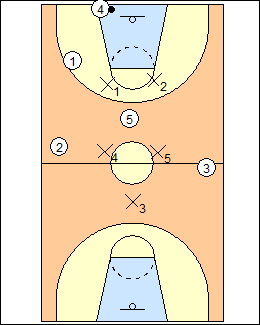 | 1 Fran Fraschilla ESPN See Hoops 101 - The 2-2-1 Press. If you dissect all presses, whether based on man-to-man or zone principles, you will see that once the ball is trapped, the defenders are in a 2-2-1 alignment. The final product of any pressure results in two trappers, two interceptors, and a safety to protect the basket. The 2-2-1 three-quarter court press was used quite a bit by the UConn Huskies during the Jim Calhoun era, with great success. It can be referred to as a "safe press", with three defenders behind the trap and less ground to cover to get back to the half-court defence. Also, it promotes the use of the sideline and halfcourt line in the defence. The basic premise of the 2-2-1 is keep the ball out of the middle of the floor. You want the offence to advance the ball down the sideline. 2-2-1 principles: - Sharp angles - Lane the passes - Surround the middle - Jump like rotations - Shoot the gaps. The Huskies put their two best "on-the-ball" defenders X1 and X2 on the front line where they can pressure the ball and force it up the sideline. X4 and X5 are on the second line, where they must "contain" the dribble on the sideline and trap, or if the ball goes away from them, rotate to cover the basket as the safety. Finally, X3 is usually the best "interceptor," because he must play sideline to sideline. This 2-2-1 does not contest the first pass to either side of the court, but there are many ways to make the 2-2-1 press "multiple". UConn gives it different looks by moving its personnel to the spots where the Huskies can be most effective. Look for the Huskies to "face guard" at times, making the 2-2-1 a true full-court press, then back off and make it a half-court press by retreating until the ball gets to the halfcourt line. In other words, the 2-2-1 can speed teams up, and at the same time, slow them down. If used correctly, this press makes teams do what they don't want to do, and that is play at your pace, not theirs. See Defences - 2-2-1 UConn, 2-2-1 Basics. |
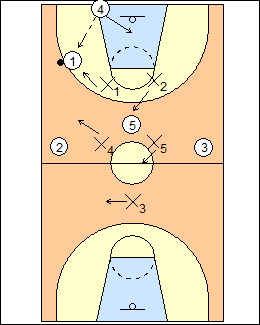 | 2 When the initial pass comes in to his side, X1 pressures the ball as X2 finds the middle man or "flash man" (here 5). X2 must stay a step removed from 5's right shoulder because they want to create the illusion he is open. Notice how X1 and X2 have created a "sharp angle." X4's job is to "lane the pass," i.e. play in the passing lane on the sideline. He must be ready to trap the dribbler advancing up the side, or return to the initial look if the ball is passed back to the inbounder. At the same time, X5 moves to the middle of the court, behind the left shoulder of the middle man. He is on a "sharp angle" with X4 and must be ready to play a long diagonal pass over his head. |
 | 3 |
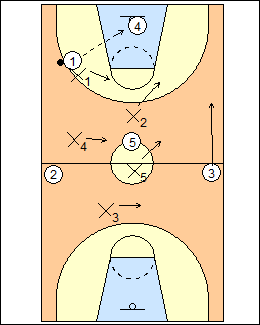 | 4 When the ball is reversed back to the inbounder, look for UConn to go back to the 2-2-1 "look" it had before the ball was inbounded and "surround the middle." On this pass, the ball is not being advanced, and the offence is using up some of its backcourt count. Teams like UConn usually do not run X2 up to the ball because they would be giving the offence a middle of the floor "look". |
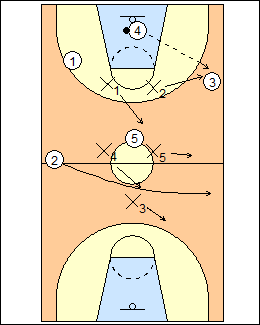 | 5 The goal now is get the offence to reverse the ball, and once it does, X2 plays the ball as X1 sinks on a "sharp angle" to the middle. It's up to X5 to "lane" any sideline pass (to encourage a soft, floating or "helium" pass over his head), allowing X4 to form his "sharp angle" with X5. X3 always moves to ballside so that if a pass is thrown over the second line defender, he can "shoot the gap" to steal the pass. |
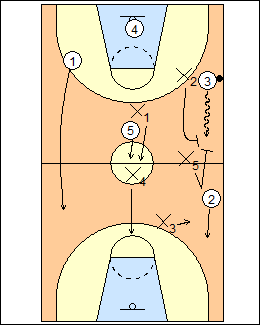 | 6 If the offence chooses to dribble up the sidelines, it's time for the rotations and trap sequences to begin. In this example, X5 retreats and only when he's sure the dribbler is coming, he "steps up" to double team with X2. X1 moves to the first person he can find in the middle of the court, looking for a deflection or a "tip from behind" if the middle man catches and puts the ball on the floor. By stepping X3 up to steal a sideline pass, we are rotating a player of size back to defend the goal as the safety (here X4). |
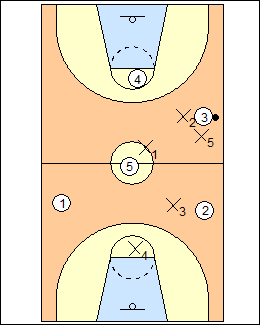 | 7 |
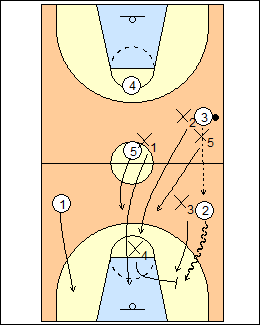 | 8 If X3 can't steal the ball on a pass to 2, he must force the ballhandler to make a sideline dribble move. The dribbler will be met by X4, where he can trap with X3. X1 rotates back to "zone the goal" as the safety, as X2 and X5 sprint out of the trap back to the lane. The importance of "sprinting out of the trap" can not be overemphasized. Often times, in rotating hard back to the lane, they a steal the "limited vision" pass that the ballhandler throws. Jim Calhoun - on a pass ahead to 2, there is a second strongside trap (deep trap), by X5 and X3. |
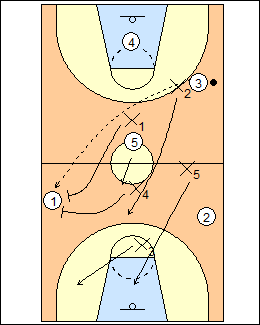 | 9 There is a difference in how to play "early" and "late" skip passes (a cross-court pass). A skip pass that originates in the back court, or "early skip", can be tracked down by both opposite defenders, X1 and X4.The players not involved in the double team have the same responsibilities, as X3 moves to the ballside of the court, X5 replaces X3 and "zones the goal", and X2 moves to the middle of the floor, replacing X5. In this case, X2 is looking to steal the limited-vision pass. Jim Calhoun - on a long pass, automatically recover to the regular halfcourt defence. Vance Walberg - vertical trap on any pass ahead between the backcourt and frontcourt hash marks. See Defences - 2-2-1 Walberg, also Villanova 1-2-2 3/4-court. |
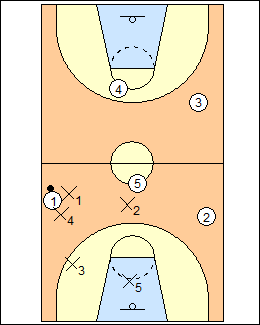 | 10 |
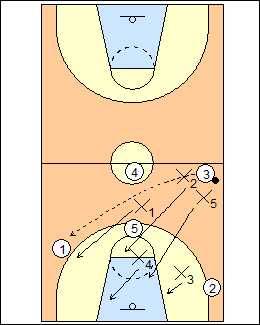 | 11 |
This page was made with Basketball playbook from Jes-Soft
